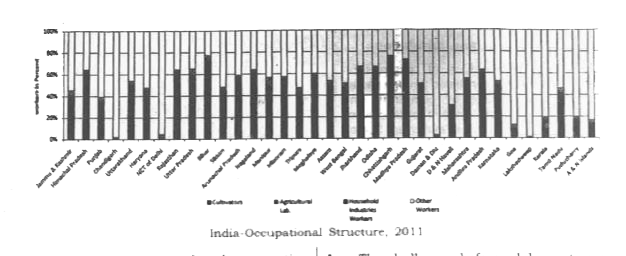What is the occupational composition of Indian's population? Give a detailed report.
Video Solution
Text Solution
The occupational composition of India.s population (which actually means engagement of an individual in farming, manufacturing trade, services or any kind of professional activities) shows a large proportion of primary sector workers compared to secondary and tertiary sectors. About 54.6 % of total working population are cultivators and agricultural labourers, whereas only 3.8% of workers are engaged in household industries and 41.6 % are industries, trade, commerce, construction and repair and other services. As far as the occupation of country.s male and female population is concerned, male workers out-number female workers in all the three sectors.
The number of female workers is relatively high in primary sector, though in recent years there has been some improvement in work participation of women in secondary and tertiary sectors.

It is important to note that the proportion of workers in agricultural sector in India has shown a decline over the last few decades (58.2% in 2001 to 54.6% in 2011). Consequently, the participation rate in secondary and tertiary sectors has registered an increase. This indicates a shift of dependence of workers from farm based occupations to non-farm based ones, indicating a sectoral shift in the economy of the country.
The spatial variation of work participation rate in different sectors in the country is very wide. For instance, the states like Himachal Pradesh and Nagaland have very large shares of cultivators. On the other hand states like Bihar, Andhra Pradesh, Chhattisgarh, Odisha, Jharkhand, West Bengal and Madhya Pradesh have higher proportion of agricultural labourers. The highly urbanized areas like Delhi, Chandigarh and Puducherry have a very large proportion of workers being engaged in other services. This indicates not only availability of limited farming land, but also large scale urbanisation and industrialization requiring more workers in non-farm sectors.
|
Topper's Solved these Questions
- POPULATION : DISTRIBUTION , DENSITY , GROWTH & COMPOSITION Book:FULL MARKSChapter:POPULATION : DISTRIBUTION , DENSITY , GROWTH & COMPOSITION Exercise:ADDITONAL QUESTIONS SOLVED ( IV. Differentiate Between )
Explore 1 Video
- POPULATION : DISTRIBUTION , DENSITY , GROWTH & COMPOSITION Book:FULL MARKSChapter:POPULATION : DISTRIBUTION , DENSITY , GROWTH & COMPOSITION Exercise:ADDITONAL QUESTIONS SOLVED ( V. Map Based Questions )
Explore 1 Video
- POPULATION : DISTRIBUTION , DENSITY , GROWTH & COMPOSITION Book:FULL MARKSChapter:POPULATION : DISTRIBUTION , DENSITY , GROWTH & COMPOSITION Exercise:ADDITONAL QUESTIONS SOLVED ( II. Short Answer Type Questions )
Explore 12 Videos
- PLANNING AND SUSTAINABLE DEVELOPMENT IN INDIAN CONTEXT Book:FULL MARKSChapter:PLANNING AND SUSTAINABLE DEVELOPMENT IN INDIAN CONTEXT Exercise:WORKSHEET
Explore 16 Videos
- POPULATION COMPOSITIONBook:FULL MARKSChapter:POPULATION COMPOSITIONExercise:Worksheet (Based Chapter -3)
Explore 8 Videos
Similar Questions
Population Composition
View SolutionDefine population composition.
View SolutionDefine population composition.
View SolutionDescribe the rural urban composition of the population?
View SolutionGive an account of the occupational structure of India's population.
View SolutionName the type of Indian population.
View SolutionWhat was the occupation of his family?
View SolutionExplain with examples the occupational structure of India's population.
View SolutionDescribe the rural-urban composition of population.
View SolutionWhat are the main occupations of Raikas?
View Solution